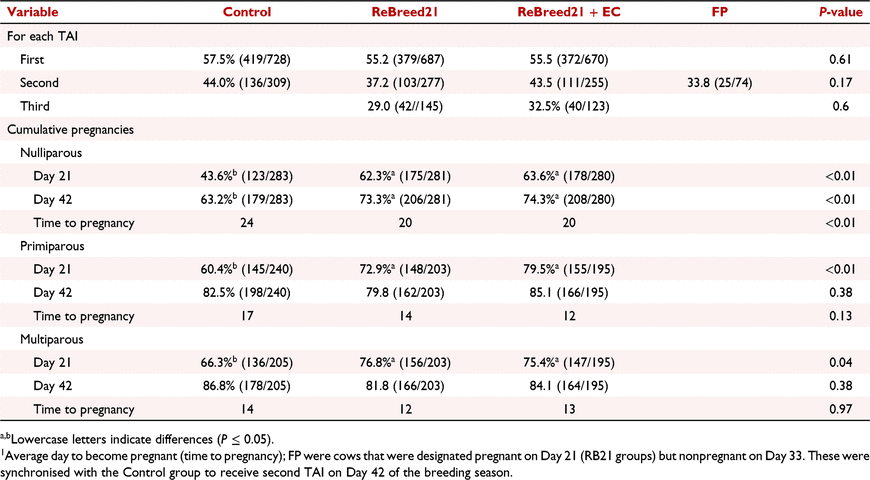126 ReBreed21, a rapid reinsemination program: fertility in Bos indicus cattle of different parities
J. P. Andrade A , P. Monteiro A , A. Prata C , A. Robl D , J. Neto D , J. R. Dias D , C. Pimenta D , B. Lippe B , A. Guimarães B , H. Ribeiro D , S. Merhi D , D. Hartmman D , R. Sartori B and M. Wiltbank AA University of Wisconsin-Madison, Madison, WI, USA
B University of São Paulo, Piracicaba, SP, Brazil
C GlobalGen Vet Science, Jaboticabal, SP, Brazil
D Agropecuária Roncador, Querência, MT, Brazil
Reproduction, Fertility and Development 34(2) 300-301 https://doi.org/10.1071/RDv34n2Ab126
Published: 7 December 2021
© 2022 The Author(s) (or their employer(s)). Published by CSIRO Publishing on behalf of the IETS
The study evaluated the efficiency of reinsemination program allowing timed AI (TAI) every 21 days (ReBreed21 (RB21); n = 1357) vs. Control (TAI every 42 days; n = 728) in Nellore females of different parities. First TAI was considered Day 0 followed by oestradiol (E2)/progesterone (P4)-based synchronisation. For RB21, all females received P4 insert on Day 12. On Day 19, P4 was removed with equine chorionic gonadotrophin (eCG) treatment (300 IU/cow; 200 IU/heifer) and 0.6 mg of E2 cypionate (RB21+EC, n = 670) or nothing (RB21, n = 687). On Day 21, Doppler ultrasound was used to determine corpus luteum blood flow (<25% = nonpregnant (NP)), and NP received 25 µg of licerelin acetate (gonadotrophin-releasing hormone, GnRH) and TAI immediately. A second RB21 program using the same groups was done in cows that received TAI on Day 21 to allow a third potential TAI on Day 42. Pregnancy diagnosis was performed on Day 33 after each TAI. Cows designated pregnant on Day 21 but NP on Day 33 were termed “false-positive” (FP). On Day 33, all Control females designated NP and FP on RB21 were resynchronised with P4+E2 synchronisation for the second TAI at Day 42. Data were analysed with SAS software (SAS Institute Inc.) and shown in Table 1. For all cows, there were no differences in the three groups (Control, RB21, RB21+EC) for pregnancy/AI (P/AI). In nulliparous heifers, cumulative pregnancies were greater for both RB21 groups compared to Controls at Day 21 or Day 42 of breeding season, with an average day to become pregnant being earlier for RB21. Primiparous and multiparous cows had greater cumulative pregnancies at Day 21 but not Day 42. Primiparous cows at second TAI had lower P/AI in RB21 (34.2%) vs. Control (51.7%); however, RB21+EC (55.8%) was similar to Control. No other parities had differences between RB21 and RB21+EC. Thus, the ReBreed21 program increases the reproductive efficiency in nulliparous and primiparous but not multiparous Bos indicus cattle. Adding EC to RB21 program only improves P/AI in primiparous cows.

|


